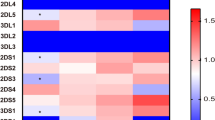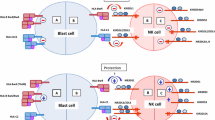Abstract
Regulating natural killer (NK) cell responses in hematological malignancies largely depend on molecular interactions between killer cell immunoglobulin-like receptors (KIR) and human leukocyte antigen (HLA) class I ligands. The goal of the current study was to examine the key functions of KIR genes, gene combinations of KIR-HLA, and KIR genotypes in genetic predisposition to aplastic anemia (AA). Herein, the genotyping of 16 KIR genes and HLA-A, -B, and -C ligands were performed in 72 AA patients and 150 healthy controls using PCR evaluations with sequence-specific primers using standard assays. According to the obtained results, AA patients had an increased incidence of activating KIR and KIR2DS4 (P = 0.465 × 10−4, Pc = 0.837 × 10−3, OR = 20.81, 95% CI = 2.786–155.5) compared to controls. KIR/HLA class I ligand profile KIR2DS4/C1 (P = 0.350 × 10−4, Pc = 0.630 × 10−3, OR = 8.944, 95% CI = 2.667–29.993) was significantly elevated in AA patients compared to healthy controls. Genotype AA1 (P = 0.003, OR = 2.351, 95% CI = 1.325–4.172) were increased, and AA195 (P = 0.006, OR = 0.060, 95% CI = 0.004–1.023) was decreased among AA cases compared to controls. Our findings indicated that KIR2DS4 may play a role in the pathogenesis of AA. This study revealed the contribution of KIR genes in the etiology of AA cases.

Similar content being viewed by others
References
Ashouri E, Ghaderi A, Reed EF, Rajalingam R (2009) A novel duplex SSP-PCR typing method for KIR gene profiling. Tissue Antigens 74(1):62–67. https://doi.org/10.1111/j.1399-0039.2009.01259.x
Augusto DG, O’ Connor GM, Lobo-Alves SC, Bass S, Martin MP, Carrington M, McVicar DW, Peazl-Erler ML (2015) Pemphigus is associated with KIR3DL2 expression levels and provides evidence that KIR3DL2 may bind HLA-A3 and A11 in vivo. Eur J Immunol 45(7):2052–2060. https://doi.org/10.1002/eji.201445324
Augusto DG, Petzl-Erler ML (2015) KIR and HLA under pressure: evidences of coevolution across worldwide populations. Hum Genet 134(9):929–940. https://doi.org/10.1007/s00439-015-1579-9
Blokhuis JH, Hilton HG, Guethlein LA, Norman PJ, Nemat-Gorgani N, Nakimuli A, Chazara O, Moffett A, Parham P (2017) KIR2DS5 allotypes that recognize the C2 epitope of HLA-C are common among Africans and absent from Europeans. Immun Inflamm Dis 5(4):461–468. https://doi.org/10.1002/iid3.178
Cai J, Liu X, Wang J, Tian W (2012) Killer cell immunoglobulin-like receptor (KIR) genes in 4 distinct populations and 51 families in mainland China. Hum Immunol 73(10):1023–1030. https://doi.org/10.1016/j.humimm.2012.07.324
Cooley S, Weisdorf DJ, Guethlein LA, Klein JP, Wang T, Le CT, Marsh SG (2010) Donor selection for natural killer cell receptor genes leads to superior survival after unrelated transplantation for acute myelogenous leukemia. Blood 116(14):2411–2419. https://doi.org/10.1182/blood-2010-05-283051
Gonzalez-Galarza FF, McCabe A, Santos EJMD, Jones J, Takeshita L, Ortega-Rivera ND, Cid-Pavon GMD (2020) Allele frequency net database (AFND) 2020 update: gold-standard data classification, open access genotype data and new query tools. Nucleic Acids Res 48(D1):D783-788. https://doi.org/10.1093/nar/gkq1029
Graef T, Moesta AK, Norman PJ, Abi-Rached L, Vago L, Older Aguilar AM, Parham P (2009) KIR2DS4 is a product of gene conversion with KIR3DL2 that introduced specificity for HLA-A*11 while diminishing avidity for HLA-C. J Exp Med 206(11):2557–2572. https://doi.org/10.1084/jem.20091010
Gwozdowicz S, Nestorowicz K, Graczyk-Pol E, Szlendak U, Rogatko-Karos M, Mika-Witkowska R, Nowak J (2019) KIR specificity and avidity of standard and unusual C1, C2, Bw4, Bw6 and A3/11 amino acid motifs at entire HLA: KIR interface between NK and target cells, the functional and evolutionary classification of HLA class I molecules. Int J Immunogenet 46(4):217–231. https://doi.org/10.1111/iji.12433
Hansasuta P, Dong T, Thananchai H, Weekes M, Willberg C, Aldemir H, Rowland-Jones S, Braud VM (2004) Recognition of HLA-A3 and HLA-A11 by KIR3DL2 is peptide-specific. Eur J Immunol 34(6):1673–1679. https://doi.org/10.1002/eji.200425089
Hou Y, Zhang C, Xu D, Sun H (2015) Association of killer cell immunoglobulin receptor and human leucocyte antigen-Cw gene combinations with systemic lupus erythematosus. Clin Exp Immunol 180(2):250–254. https://doi.org/10.1111/cei.12582
Jamil KM, Khakoo SI (2011) KIR/HLA interactions and pathogen immunity. J Biomed Biotechnol 2011:298348. https://doi.org/10.1155/2011/298348
Jobim M, Chagastelles P, Salim PH, Portela P, Wilson TJ, Curti AG, Jobim MR (2010) Association of killer cell immunoglobulin-like receptors and human leukocyte antigen-C genotypes in South Brazilian with type 1 diabetes. Hum Immunol 71(8):799–803. https://doi.org/10.1016/j.humimm.2010.05.014
Jost S, Altfeld M (2013) Control of human viral infections by natural killer cells. Annu Rev Immunol 31:163–194. https://doi.org/10.1146/annurev-immunol-032712-100001
Kordasti S, Marsh J, AI-Khan S, Jiang J, Smith A, Mohamedali A, Mufti GJ, (2012) Functional characterization of CD4+ T cells in aplastic anemia. Blood 119(9):2033–2043. https://doi.org/10.1182/blood-2011-08-368308
Liu C, Sun Y, Shao Z (2019) Current concepts of the pathogenesis of aplastic anemia. Curr Pharm Des 25(3):236–241. https://doi.org/10.2174/1381612825666190313113601
Machado-Sulbaran AC, Ramírez-Dueñas MG, Navarro-Zarza JE, Muñoz-Valle JF, Mendoza-Carrera F, Baños-Hernández CJ, Sánchez-Hernández PE (2019) KIR/HLA gene profile implication in systemic sclerosis patients from Mexico. J Immunol Res 2019:6808061. https://doi.org/10.1155/2019/6808061
Martin MP, Qi Y, Gao X, Yamada E, Martin JN, Pereyra F, Carrington M (2007) Innate partnership of HLA-B and KIR3DL1 subtypes against HIV-1. Nat Genet 39(6):733–740. https://doi.org/10.1038/ng2035
Middleton D, Gonzelez F (2010) The extensive polymorphism of KIR genes. Immunology 129(1):8–19. https://doi.org/10.1111/j.1365-2567
O’ Connor GM, Guinan KJ, Cunningham RT, Middleton D, Parham P, Gardiner CM, (2007) Functional polymorphism of the KIR3DL1/S1 receptor on human NK cells. J Immunol 178(1):235–241. https://doi.org/10.4049/jimmunol.178.1.235
Pamuk GE, Tozkir H, Uyanik MS, Gurkan H, Duymaz J, Pamuk ON (2015) Natural killer cell killer immunoglobulin-like gene receptor polymorphisms in non-Hodgkin lymphoma: possible association with clinical course. Leuk Lymphoma 56(10):2902–2907. https://doi.org/10.3109/10428194.2015.1014361
Peng H, Tian Z (2018) NK cells in liver homeostasis and viral hepatitis. Sci China Life Sci 61(12):1477–1485. https://doi.org/10.1007/s11427-018-9407-2
Rajalingam R (2018) Diversity of killer cell immunoglobulin-like receptors and disease. Clin Lab Med 38(4):637–673. https://doi.org/10.1016/j.cll.2018.08.011
Shahsavar F, Tajik N, Entezami KZ, Fallah Radjabzadeh M, Asadifar B, Alimoghaddam K, Ghavamzadeh A (2010) KIR2DS3 is associated with protection against acute myeloid leukemia. Iran J Immunol 7(1):8–17
Shi L, Zhang H, Shen Y, Dong Y, Li Y, Dong Z, Yu J (2013) Distribution of KIR genes in Han population in Yunnan Province: comparison with other Han populations in Chian. Int J Immunogenet 40(5):361–368. https://doi.org/10.1111/iji.12046
Theeranawakam A, Vejbaesya S, Khuhapinant A, Sae-Tam P (2021) Killer cell immunoglobulin-like receptors in Thai patients with multiple myeloma. Asian Pac J Allergy Immunol. https://doi.org/10.12932/AP-130520-0842
Tuttolomondo A, Di Raimondo D, Pecoraro R, Casuccio A, Di Bona D, Aiello A, Pinto A (2019) HLA and killer cell immunoglobulin-like receptor (KIRs) genotyping in patients with acute ischemic stroke. J Neuroinflammation 16(1):88. https://doi.org/10.1186/s12974-019-1469-5
Uhrberg M, Valiante NM, Shum BP, Shilling HG, Lienert-Weidenbach K, Corliss B, Tyan D, Lanier LL, Parham P (1997) Human diversity in killer cell inhibitory receptor genes. Immunity 7(6):753–763. https://doi.org/10.1016/s1074-7613(00)80394-5
Vierra-Green C, Roe D, Hou L, Hurley CK, Rajalingam R, Reed E, Lebedeva T (2012) Allele-level haplotype frequencies and pairwise linkage disequilibrium for 14 KIR loci in 506 European-American individuals. PLoS One 7(11):e47491. https://doi.org/10.1371/journal.pone.0047491
Wang HD, Zhang FX, Shen CM, Wu YM, Lv YG, Xie ST, Zhu BF (2012) The distribution of genetic diversity of KIR genes in the Chinese Mongolian population. Hum Immunol 73(10):1031–1038. https://doi.org/10.1016/j.humimm.2012.07.317
Wang HD, Zhu BF, Shen CM, Fan AY, Song TN, Liu JL, Yan CX (2011) Diversity distribution of killer cell immunoglobulin-like receptor genes and their ligands in the Chinese Shaanxi Han population. Hum Immunol 72(9):733–740. https://doi.org/10.1016/j.humimm.2011.04.003
Wang T, Shen C, Chen L, Liu S, Ji Y (2017) Association of human leukocyte antigen polymorphisms with occult hepatitis B virus infection in a Shaanxi Han population. J Gene Med 19:9–10. https://doi.org/10.1002/jgm.2987
Warrington KJ, Takemura S, Goronzy JJ, Weyand CM (2001) CD4+, CD28-T cells in rheumatoid arthritis patients combine features of the innate and adaptive immune systems. Arthritis Rheum 44(1):13–20. https://doi.org/10.1002/1529-0131(200101)44:01%3c13::AID-ANR3%3e3.0.CO;2-6
Yang C, Zhang X (1991) Incidence survey of aplastic anemia in China. Chin Med Sci J 6(4):203–207
Young NS, Kaufman DW (2008) The epidemiology of acquired aplastic anemia. Haematologica 93(4):489–492. https://doi.org/10.3324/haematol.12855
Zhang Y, Wang B, Ye S, Liu S, Liu M, Shen C, Qi J (2010) Killer cell immunoglobulin-like receptor gene polymorphisms in patients with leukemia: possible association with susceptibility to the disease. Leuk Res 34(1):55–58. https://doi.org/10.1016/j.leukres.2009.04.022
Zhen J, Wang D, He L, Zou H, Xu Y, Gao S, Deng Z (2014) Genetic profile of KIR and HLA in southern Chinese Han population. Hum Immunol 75(1):59–64. https://doi.org/10.1016/j.humimm.2013.09.006
Zhu BF, Wang HD, Shen CM, Deng YJ, Yang G, Wu QJ, Wang ZY (2010) Killer cell immunoglobulin-like receptor gene diversity in the Tibetan ethnic minority group of China. Hum Immunol 71(11):1116–1123. https://doi.org/10.1016/j.humimm.2010.07.010
Acknowledgements
We are grateful to all the volunteers who were willing to participate into this study.
Funding
This research was supported by the Natural Science Foundation of Xi’an Health Commission (20180509YX3SF29).
Author information
Authors and Affiliations
Contributions
J.W., L.S., and L.C. performed the experiments, analyzed the data, and wrote up the results. T.W., M.W., H.X., and Y.L. planned the experiments, analyzed the data, created the figures, and wrote the manuscript. J.Q. is the guarantor of this work and, as such, had full access to all the data in the study and takes responsibility for the integrity of the data and the accuracy of the data analysis.
Corresponding author
Ethics declarations
Ethical approval and consent to participate
To conduct the current study, approval was provided by institutional review committees at the Shaanxi Blood Center and the local ethics committee. Furthermore, both healthy individuals (the control group) and AA patients gave their written consent after getting all the necessary information. Consent was given after a thorough explanation, as specified by the Declaration of Helsinki.
Conflict of interest
The authors declare no competing interests.
Additional information
Publisher's Note
Springer Nature remains neutral with regard to jurisdictional claims in published maps and institutional affiliations.
Supplementary Information
Below is the link to the electronic supplementary material.
Rights and permissions
Springer Nature or its licensor (e.g. a society or other partner) holds exclusive rights to this article under a publishing agreement with the author(s) or other rightsholder(s); author self-archiving of the accepted manuscript version of this article is solely governed by the terms of such publishing agreement and applicable law.
About this article
Cite this article
Wang, T., Qi, J., Wang, M. et al. Correlation between human leukocyte antigen ligands and killer cell immunoglobulin-like receptors in aplastic anemia patients from Shaanxi Han. Immunogenetics 75, 445–454 (2023). https://doi.org/10.1007/s00251-023-01316-6
Received:
Accepted:
Published:
Issue Date:
DOI: https://doi.org/10.1007/s00251-023-01316-6




